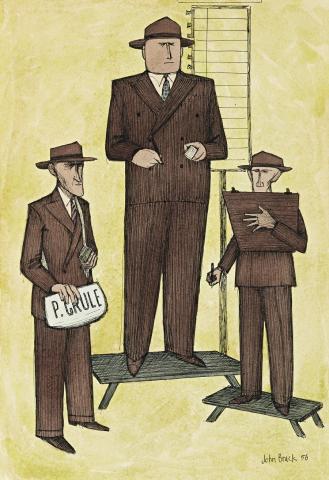THE BOOKMAKER, 1956
JOHN BRACK
watercolour, pen and ink on paper
42.0 x 29.0 cm
signed and dated lower right: John Brack 56
Peter Bray Gallery, Melbourne (label attached verso)
Gerald Griffin, Melbourne, acquired from the above 9 November 1956
Thence by descent
The Estate of Eileen Griffin, Melbourne
Grishin, S., The Art of John Brack, Oxford University Press, Melbourne, 1990, vol. I, p. 58, vol. II, cat. p56, p. 48
In Melbourne, the month of November is heralded in with the running of the Melbourne Cup. The nation stops to listen. In 1956 John Brack presented his Racecourse Series of watercolours and four prints at Melbourne's Peter Bray to coincide with this annual carnival. The twenty-six works exhibited covered a range of racing subjects horses, jockeys, trainers, a steeplechase, stewards, spectators and our work, The Bookmaker. Each is characterized by a sharp and witty line, which matches the incisive psychological penetration of the artist. The lines of experience on the faces of the jockeys are as marked as engravings; yet they remain anonymous through their mask-like visages. This same anonymity is found elsewhere, in the broad backs of stewards and trainers. In the watercolour Mounting, the view of horse, jockey and trainer is likewise a rear one, as crowds remain faceless, or close up wear the almost skull-like masks seen before. While the bookmaker is satirically identified as 'P. Crule', he and his assistants look more like automatons than human beings. Satire is carried further in Brack's use of size, frontal symmetry and broad shoulders to indicate the importance of the bookmaker. At the height of his physical powers, he towers over his two clerks, older, shorter and angled to the picture plane. Yet, their suits are brown with creases as sharp as their characters. Hats reign supreme as part of the correct dress code of the 'fifties, each figure a contemporary of those who people Brack's early masterpiece Collins Street, 5PM painted the previous year. The stark background of mustard yellow gives the picture an additional bite, revealing once again Brack's inventive skills as a social satirist, master of irony and acerbic commentator. But Brack is not without sympathy for the human condition. His biographer, Sasha Grishin wrote, 'A number of the other drawings including Jockey and trainer, The stipendiary stewards, Two ladies, and The bookmaker looked at specific human relationships formed under the conditions of ritual imposed by horse-racing conventions.'1
It is no surprise to learn that the 1956 exhibition was critically well received and about half of the works were sold. When Brack visited the Caulfield and Flemington racecourses armed with his sketchbook in the winter of 1956, from which this series developed, he was following a tradition long popular in Western art. The eighteenth-century English master painter of horses, George Stubbs, was among the many notables attracted to the sport of horse racing, as was the French Impressionist Edgar Degas. While Stubbs and Degas gave us noble images of that most romantic of all animals, offset by the beautiful and the fashionable, Brack applied his eye like a scalpel to this sport of kings.
1. Grishin, op.cit., vol. I, p. 58
DAVID THOMAS
